Are you looking to create a food delivery app? Well, who doesn’t?
With diverse choices, accessibility, and convenience of ordering food from the comfort of your couch, food delivery apps have amassed huge popularity within a few years.
A study found that 86% of Americans ordered food delivery at least once a month. And, among them, Millennials & Gen-Z are winning the race by spending a chunk of their paychecks on food delivery & restaurants.
Furthermore, online ordering is growing 300% times faster than in-house dining. That’s huge, right? If you are planning to capitalize, you have reached the right blog.
Through this food delivery app development guide, you will get to know about every vital knowledge necessary to embark on this journey. Let’s get started:
What are Food Delivery Apps?
Food delivery apps are software that provides a suitable way to order food that is delivered to the doorstep. It connects consumers with restaurants, and third-party services & lets them order food from anywhere. Apart from food, you can order groceries too.
The lockdown and staying in has increased people ordering food from outside. It became one of the leading causes of the increased acceptance of food delivery apps.
Now, it is projected that the food delivery app industry will reach a $165 billion market by 2029. Although, there are many food delivery apps in the market, among them Uber Eats & DoorDash are the most popular and Delivery Hero has united users.
With that, let’s understand how the food delivery app works:
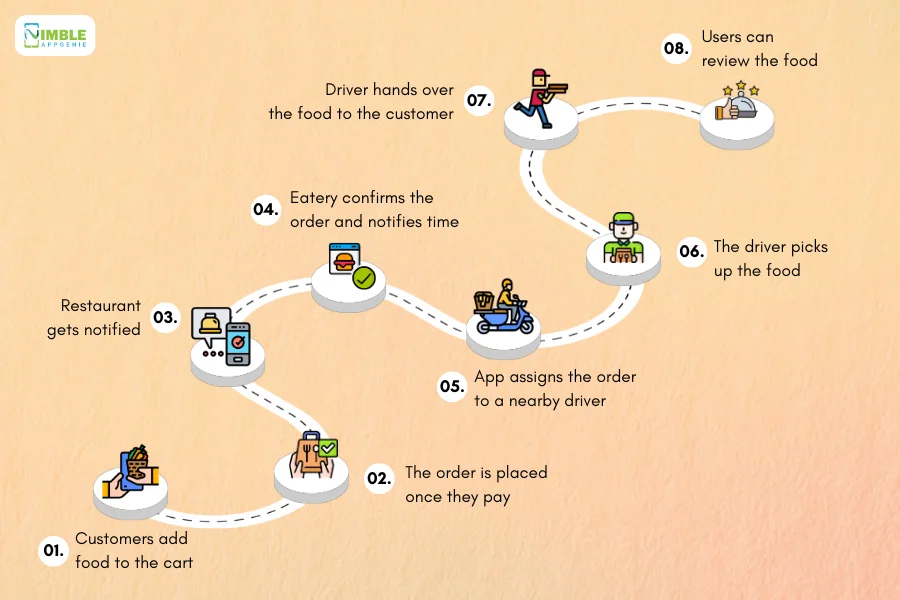
With the popularity of these apps, you might be wondering if it will be the right time to go for mobile app development. Well, yes.
In the words of Doordash CEO Tony Xu, “The biggest trend we’re seeing is the rise of mobile ordering. People are increasingly comfortable ordering food through their phones.”
Undoubtedly, this is the prime opportunity to invest in the food industry. With features like saving time, convenience, & affordability, there are so many varieties to choose from, the future is bright for those who invest in it now.
Food Delivery App Market Overview
To know about a market, the best way to look into it. And, that’s exactly what we will do in this section.
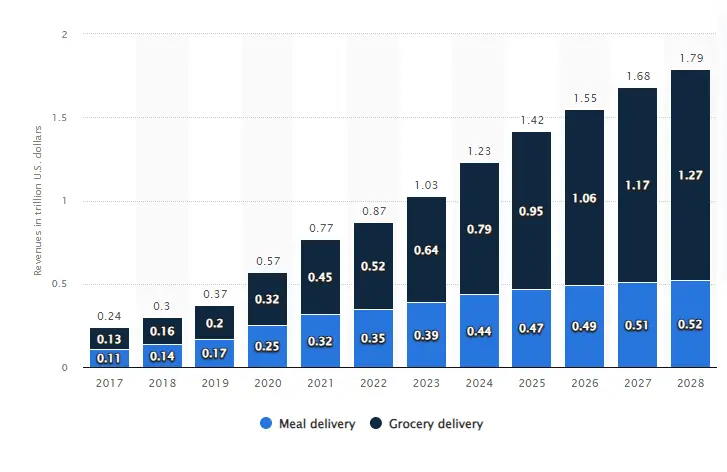
As per Statista, the global food delivery app market sector was estimated over $ 1 trillion last year among which 640 billion was earned from grocery delivery and 390 bn from meal delivery.
Also, here are some other stats that might interest you:
- Revenue in the food delivery market is likely to reach $1.22tn in 2024.
- Among other countries, the USA and China are likely paving the way.
- During the forecast period, (2024-2028) the market will grow at a CAGR OF 10.06%.
- Growth in 20.3%is expected in 2025 in the grocery delivery market.
- Whereas, the Meal delivery market will see an increase of users to 2.5 bn by 2028.
Overall, we just want to convey that modern food delivery apps like Postmates have made it convenient for people to order and made businesses interested to develop food delivery apps.
To know more about its benefits, you must go through the next section.
Benefits of Developing a Food Delivery App
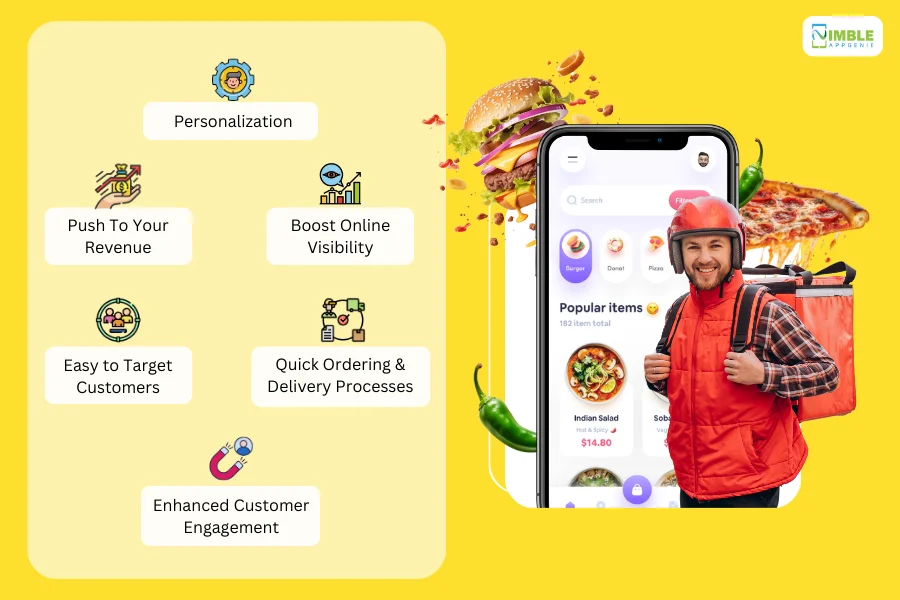
What is the benefit of developing a food delivery app for your business? Why should you invest in one? In case, you are thinking about the same.
There are several benefits of building a food delivery app, and this section will clear your head about it.
Check them out:
1. Push Your Revenue
Developing a food delivery app can give a significant push to your revenue. You can target wide-ranging customers from vegans, vegetarians to meat eaters.
And, with the growing trend of ordering in, your app will gain more exposure as a convenient option. As a result, existing customers will order more frequently boosting order volume. This translates to more sales resulting in increased revenue.
2. Personalization
With feature-rich food delivery app, you can provide a personalized experience to the user.
You can get insights about them such as search history, or add to-cart items and send them notifications or reminders for the food they are looking for.
This way, you can motivate your users to make payments and order food.
3. Boost Online Visibility
In digital time, when everything is connected to mobile apps, developing a food delivery app is a smart idea that can increase your visibility among people. Through that, you can connect with more and more customers and approach them to use your app.
4. Easy to Target Customers
Gone are the days of newspaper ads and flyers, with a food delivery app, you can target your customers with new marketing campaigns and drive them to your app.
The best part is your app can target a huge number of customers which is not possible manually and that too in less time.
5. Quick Ordering and Delivery Processes
As you know, food delivery apps streamline the ordering & delivery processes, they make it easy for restaurants and customers to order, make payments, and track their whereabouts. This increases customer engagement on such apps resulting in more revenue.
6. Enhanced Customer Engagement
If you have a well-designed app, it can become a line of communication for customers. You can gain insights about their preferences and ordering habits, and timely target them through your app; this will not only foster positive relations with your customers but also encourage repeat business.
If you understand the importance of food delivery apps, then time to know about some market-leading features that can make your food delivery app successful.
Features That Can Determine the Success of Your Food Delivery App
Growth & success of any app comes from what it has to offer to its users, which is why features play an important role.
With thorough research, we decided to put the best & must-have features that can make your food delivery app a giant success.
So, let’s take a look at them:
A] User-Panel Features
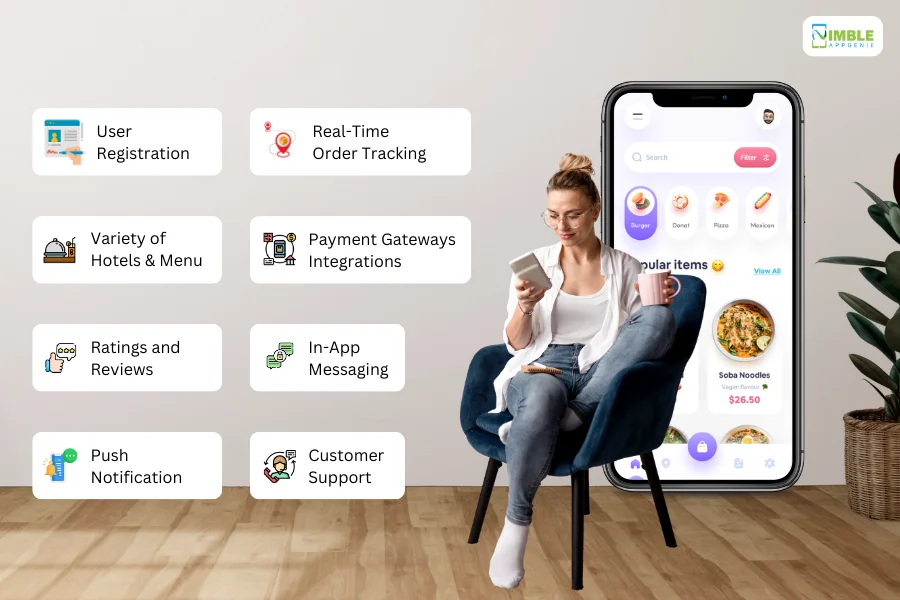
If you are planning to create a food delivery app, it is necessary to consider some of the user-friendly features.
-
User Registration
To help users onboard the app easily, you should keep the registration simple & minimalistic.
No user wants to fill out long forms; this will drive them away which as an entrepreneur you don’t want. Therefore, it is advised to make the registration feature as simple and easy as you can.
-
A Variety of Hotels & Menu
You need to offer them access to a variety of hotels, and cuisines so that they can choose easily. The menu should cover dish images, ingredients, and customization options.
-
Payment Gateway Integrations
Integrate different payment gateways such as debit/credit card or cash. This way, you can offer them a variety of options to make payments. Providing a seamless payment gateway will increase the chances of order completion and increase the trust of the user.
-
Real-Time Order Tracking
We all know the feeling that once we place the food; we can’t help but check our order and how long it’ll take to reach which is why we believe your users will love this feature in your app.
-
Push Notification
Utilizing push notification services to create a food delivery app is indeed a clever move. You can let them know about their order status and deals or send personalized messages to target them timely.
-
Ratings and Reviews
Feedback is important, maybe your user can tell such aspects that were not in your knowledge. Also, allowing them to rate and review will help other people to make more informed decisions.
-
In-app messaging
An in-app message can be a great way to keep all parties updated. This helps users to connect with the riders as well as restaurants for a quick concern or update and vice-versa for both parties too.
-
Customer Support
Most food-delivery apps have in-built support to help users in times of need. It’s a quick & easy way to get help, you should provide multiple options such as FAQs, submit a request, or start a live chat.
B] Rider-Panel
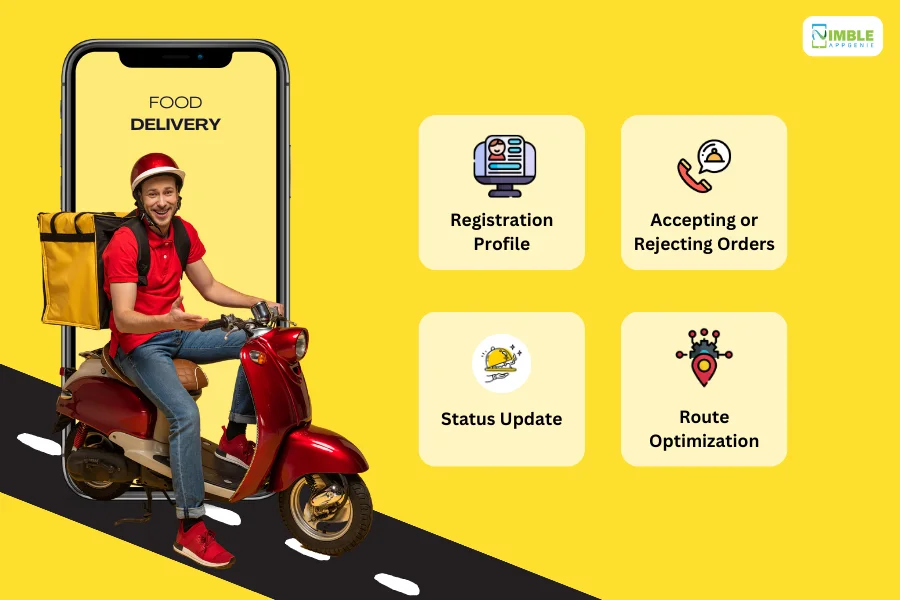
For the comfort of delivery guys, here are some of the best features that you can explore.
-
Registration Profile
With some easy & quick steps, allow your rider to register to the app. Make sure to thoroughly verify their identity and once it’s done. Let them receive orders and deliver them precisely.
-
Accepting or Rejecting Orders
Allow your delivery guy to accept or reject any order for any reason such as distance, pay, or any other. Through notifications, allow them to view new order requests.
-
Status Update
Let your rider update the food order status within the app, this way customers can know about the picked & estimated delivery time. As a result, this will create more transparency and build user trust in your app.
-
Route Optimization
This feature can help riders to know about the best route to take to reach a particular location, leading to significant savings in fuel cost and time. This translates to faster delivery and happy customers resulting in increasing profits for the business.
C] Restaurant-Panel
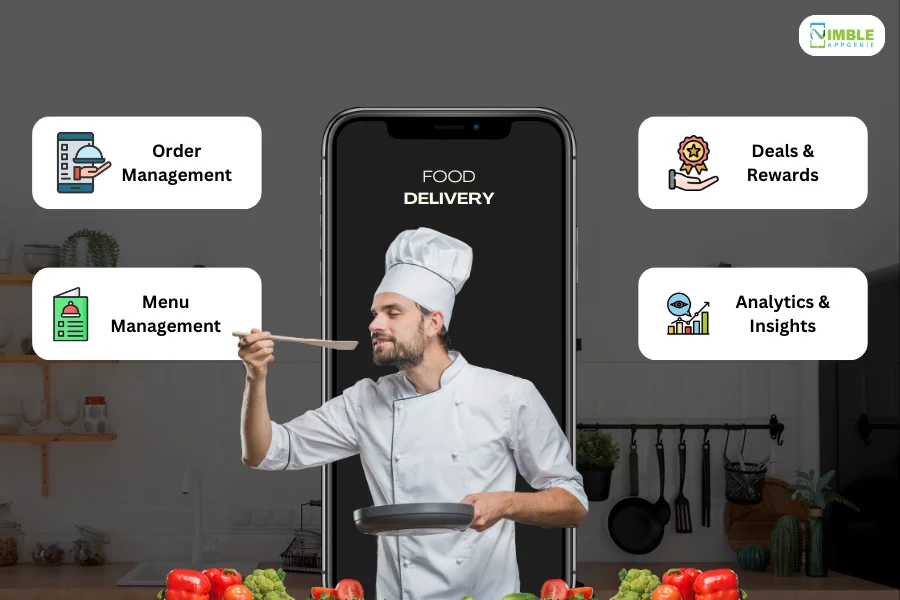
After all, the restaurant that is preparing food for customers needs to have some features for them too.
-
Order Management
Let restaurants accept or reject an order depending on different factors such as closing time, or ingredient availability. Also, once the food is prepared, inform the customer about the food and estimated delivery time.
-
Menu Management
Allow restaurants to easily edit, manage, or remove any item from their menu as per availability. This will dodge overselling & unsatisfied customers.
-
Deals and Rewards
Another feature necessary to create a food delivery app is to create new offers, discounts, and deals as per their choice to boost sales.
-
Analytics & Insights
Analytics is like a goldmine of information through which they can track the most-selling products, identify peak hours, and more. This way they can refine their product & services as per customer preferences.
D] Admin Panel
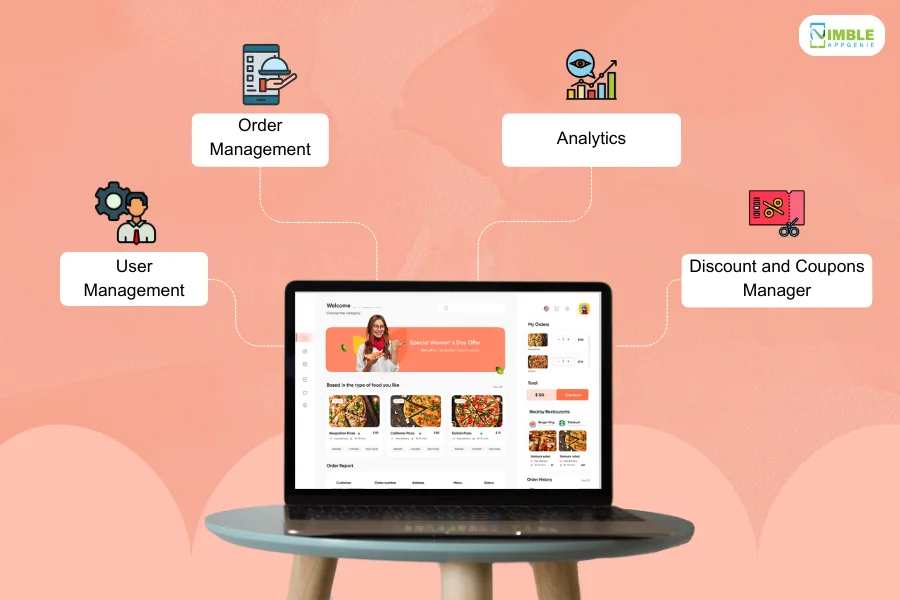
To control the app, here are some features necessary to integrate into food delivery app:
-
User Management
As you know there are restaurants, users, and driver panels in the food delivery app, admin needs to manage them timely. You can add, edit, or deactivate accounts, address issues, and resolve them from the app’s end.
-
Order Management
You can track all the orders placed & track their status, this way you can easily help with user issues and streamline communication.
-
Analytics
Through this feature, admins can keep track of trends, user preferences, and active hours. Also, understand areas of improvement for a better understanding of the business.
-
Discount and Coupons Manager
Managing system-wide promotions, discounts, and programs is necessary to attract and retain users. 92% of people believe in looking for coupons regularly, to satiate their demand, so this feature is of use.
We believe you now understand that features play an important role in making or breaking your app’s success. By analyzing your user needs and your target audience, you can make an app like Doordash or maybe better.
Talking about the creation of the app, let’s move to our next section where we will be talking about the same.
How to Develop a Food Delivery App?
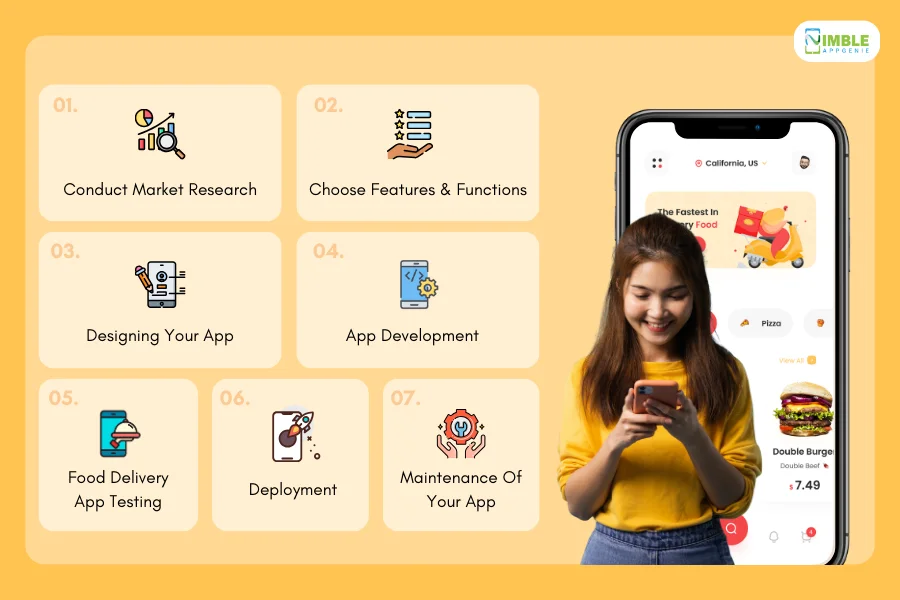
Your mind must be wondering with thought how to create a food delivery app?
In order to do so, you need to pay attention to this section of the blog, where we will be talking about the step-by-step development process.
Step 1: Conduct Market Research
This exciting endeavor starts from a thorough market app research where you get in-depth knowledge of your target audience, learn about their pain points and challenges, and try to solve them with a solution.
Other than that, you need to research your competitor to know about their products and what they are offering.
Doing so will lead you to have a better foundation for your app & will drive your business towards growth.
Step 2: Choose Features & Functions
This is why we mentioned the necessary features above as it is the most important part of a food delivery app.
Make sure to choose features that enhance your user experience and are predefined. This will save you from wastage of time, effort, and cost overrun.
Step 3: Designing Your App
Next is to lay focus on UI/UX Design.
It’s time to work on the side that will interact with the user; you should make the UI visually appealing yet simple. This is where elements like branding, color scheming, and typography play a crucial role. You can make sure to create an app that is functional as well as eye-pleasing leading to a user-friendly app.
Time to work on “development” that takes us to the next step.
Step 4: App Development
App development consists of two segments:
- Front-end development- Building the components of the user interface aiming to increase positive user experience.
- Back-end development – Back-end development includes working on server-side software focusing on writing code, databases, APIs, and much more.
It is an important and longest process in the app development process. So, make sure to communicate with the developers for the well-organized food delivery app.
Step 5: Food Delivery App Testing
The next step is mobile app testing where the app is tested on different levels such as functionality, app security, usability, etc to ensure it is up to market standards.
Also, if there are any bugs or issues found, they are immediately eliminated to ensure a smooth user experience.
Step 6: Deployment
Once the final version of your app is ready, it’s time to deploy the app.
You can submit an app to the App Store or publish the Android App in the Play Store as per your choice. Once your app is sent for review, it will take some time approx. two weeks to hear back from them.
Step 7: Maintenance of Your App
Once the app is deployed, the work is far from over.
Now, you should work on user feedback, fixing bugs and technical issues to keep the app functional and optimized for the app store through support and maintenance services.
With that, you understood the steps to create a food delivery app, now it’s time for you to learn about another important part that is:
Tech Stack of Food Delivery App
Tech Stack, famously known as the data ecosystem.
Whether you want to develop a meat delivery app, food delivery app, or grocery app, a tech stack plays an important role.
It can affect the speed, security, & user experience so choosing the right app tech stack is the foundation of development.
Here is a small breakdown of what goes in to make your food delivery app:
| Basis | Technologies |
| Front End Development | React Native, Flutter, and Swift |
| Back End Development | Node.js, Python, Ruby on Rails |
| Database | MySQL, and MongoDB |
| Payment Gateways | Stripe, PayPal, and Braintree |
| Mapping & Geolocation | Google Maps, HERE maps |
| Cloud platform | Azure, Amazon Web Services, and Google Cloud platform. |
| Push Notification | Amazon Simple Notification Services and Firebase Cloud Messaging. |
| Analytics | Google Analytics |
However, it is totally on your project’s complexity and the team’s expertise that technology will be of use. But this will give you an idea.
How Much Does It Cost to Develop a Food Delivery App?
So how much does it cost to make a food delivery app?
The food delivery app development cost can range from $30,000 to $100,000 depending on the complexity and features of your app. Every little too little or big aspect affects the cost to make a food ordering app.
For instance, if you want to develop an Android App and you hire Android app developers, they will be more costly for you than hiring an iOS developer because Android development is more fragmented and complex to work on.
Similarly, the complexity of your food delivery app also impacts your overall cost such as:
| Basis | Cost | Description |
| Basic App | $30,000-$50,000 | Include basic functionalities such as menu viewing, order placing, and tracking delivery. |
| Mid-level App | $50,000-$70,000 | Include features like real-time order tracking, payment processing, in-app chat, and user management. |
| Advanced App | $70,000-$100,000 | Multi-language support, AI integration, advanced analytics, loyalty programs |
However, there are other factors too that may have their role in increasing or decreasing your cost to develop food delivery app which we will discuss in the next section.
Factors Affecting Food Delivery App Development Cost
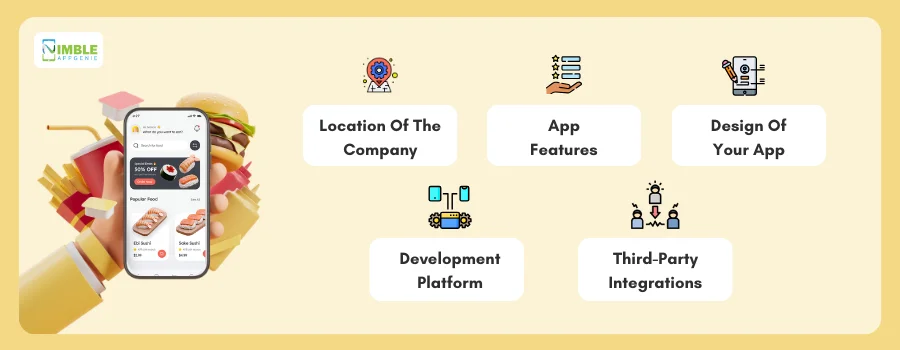
Before you embark on this journey, let’s introduce you to some other cost-affecting factors.
1. Location of the company
If you are outsourcing your development company, you need to know that location plays an important role.
For instance, if you are going for a mobile app development company in London (UK) the cost may be slightly greater than that of other countries like Eastern Europe or Asia.
As for other countries, they too have different hourly rates and costs. Since we have already shared so much; let’s see the hourly rates in other countries through a table:
| Country | Hourly rate |
| USA | $100-$150 |
| UK | $80-$100 |
| Australia | $60-$80 |
| Eastern Europe | $40-$60 |
| Asia | $25-$50 |
With that, it’s time to move to another cost-affecting factor.
2. App Features
Features are the backbone of food delivery applications.
Basically, they are divided into two parts, one is basic which is cost-efficient but comprises only necessary features such as user login, navigation, ordering food, etc.
Whereas, advanced features may include cutting-edge app security, AI, real-time features, etc. This will increase the cost to develop an app as it is time-consuming and requires more effort from the development end too.
3. Design Your App
Whether you are working on iOS app design or Android design, the cost can vary. Apart from the platform, in general also if your design is simple, it will be more economical than that of a custom app design.
As the custom app design needs more iterations on it leading to increased app design costs. And, this is why it is a factor you should consider well.
4. Development Platform
As you know, how to build a food delivery app, it is necessary to choose a platform as per your target audience.
Well, there are two options for development platforms, one is native app development another is cross-platform development. The latter one is a lot cheaper than a native platform, although both these development platforms have their perks and difficulties, you should choose wisely.
5. Third-Party Integrations
Yes, this is yet another important factor for you to consider in ‘how to develop a food delivery app’.
To develop an app like Deliveroo or Uber Eats, third-party integration is necessary.
Basically, this integration consists of different features that are necessary for the success of your apps such as mapping services, push notifications, and more that come with different subscription & setup fees. And this might be a pricey endeavor.
To reduce their cost, you need to consider the necessary integration for your app and make sure to not overload it with unnecessary additions.
By carefully considering all the factors you can make your food delivery app while keeping the cost to develop an app under control.
These are some of the points you need to take care of while working on food delivery app.
Now, let’s understand how you will earn revenue from your app.
Monetization Strategies for Food Delivery App
So, how will your app earn money? You might be wondering the same.
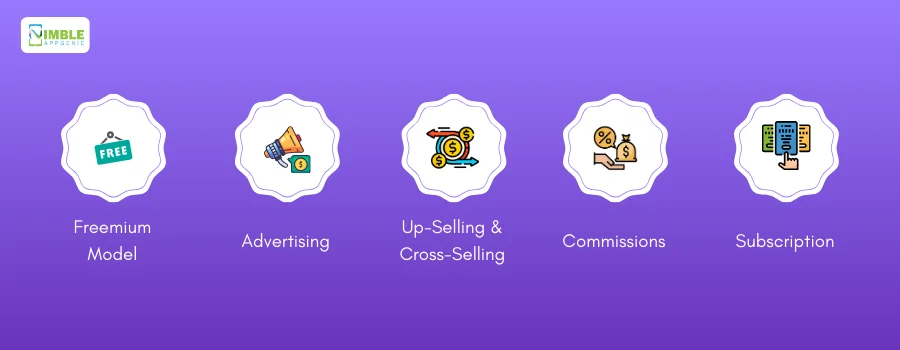
Let’s talk about some app monetization strategies that are leveraged by your competitors and you can do it too.
-
Freemium Model
Through this model, you can let your user enjoy the free version of the app offering basic content, and ask to upgrade to a paid version for advanced features.
Ideally, the catch here is, that with so many free apps available, you need to give your users a reason to pay for advanced features. So, make sure to work on that.
-
Advertising
It is one of the old practices where you can feature different ads on your platform to your users. This way you can keep the app free while still earning from it.
There are many different types of ads available such as Interstitial Ads, Banner Ads, and Rewarded Video Ads to choose from.
-
Up-selling & Cross-selling
Something different, right?
So basically, in this model, you can use your app to suggest add-on items and complementary dishes, which is a common way for food delivery apps to increase food volume and enjoy some extra chunk of money.
-
Commissions
Another marketing technique used by food delivery apps like DoorDash is commissions, you can charge commission on orders placed through your platform. This way you can open a new revenue stream for your food delivery app.
-
Subscription
Food delivery is gaining momentum at current times, and with that, these food delivery apps have regular visitors too.
You can leverage this through subscriptions and allow them to pay extra to get an ad-free experience, unlimited free delivery, and much more for a certain time. This will boost your growth and open a new source of income for your app.
We hope you understand & now have enough reasons to invest in mobile apps, but one important aspect among all is partnering with the best development company that takes us to our next section.
How Nimble AppGenie Can Help You to Build a Food Delivery App?
You deserve the best food delivery app possible. For this, partnering with a top food delivery app development company, Nimble AppGenie, can ensure a smooth & successful journey from concept to launch.
With our expert wealth of knowledge in crafting mobile apps, specifically within the food delivery domain. We work to understand your requirements, market trends, and technical resources to put the best and provide you with a robust and scalable app.
Hire mobile app developers from us, and get started today.
Conclusion
In essence, all this information points toward the direction that the food delivery app market is growing and there are no signs of slowing down.
It is the best time to take your food business online, connect with customers effectively and efficiently, and drive growth for your business.
If you are ready to be part of this growing trend of food delivery apps, we are right here to assist you. Just contact us and our experts will reach out to you for further discussion.
FAQs
To create a food delivery app, you need to connect with the best food delivery app development companies such as Nimble AppGenie. With their expertise and skills, you can get a market-leading food delivery app.
To create a food delivery app, the cost can be between $30,000-$100,000 depending on features, complexity, location, and other factors it can vary.
Yes, there are several ways they make a profit such as charging commissions, showing ads, subscriptions, freemium models, and much more.
The best way to create a food delivery app:
- Research the market
- Do competitor analysis
- Focus on features
- UI/UX designing
- Development
- Testing & Launching your app
- Maintenance of the app
The time taken to make a delivery app depends on the requirement of your project, It can go from a few weeks to months. Overall the time is somewhere between 4 to 6 months depending on the features, and complexity.
Some of the essential features you should have in a food delivery app are:
- Easy Registration.
- Payment gateway options.
- Push notification.
- Food tracking option.
- Easy order placement.
- Customer Support.
Food delivery works in the following way:
- Customers open the app and add their food to the cart
- The order is placed once they pay for it
- Restaurant gets notified about the order
- Eatery confirms the order and notifies time to customer
- Once the food is ready, the app assigns the order to a nearby driver
- The driver picks up the food and secures it for delivery
- Driver then reaches the location and hands over the food to the customer
- Users then can review the food and overall experience
Some of the famous food delivery apps are:
- Uber Eats.
- Instacart.
- DoorDash.
- Delivery.com
- Amazon Flex.
- Eaze.
- Bite Squad
- Cavi

Niketan Sharma is the CTO of Nimble AppGenie, a prominent website and mobile app development company in the USA that is delivering excellence with a commitment to boosting business growth & maximizing customer satisfaction. He is a highly motivated individual who helps SMEs and startups grow in this dynamic market with the latest technology and innovation.
Table of Contents




No Comments
Comments are closed.